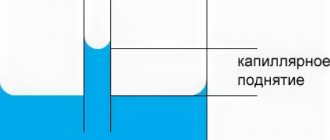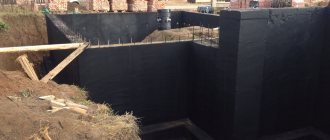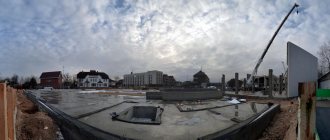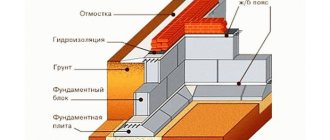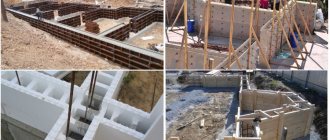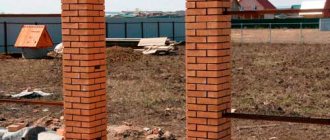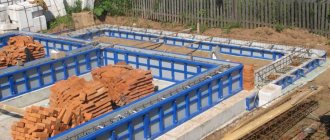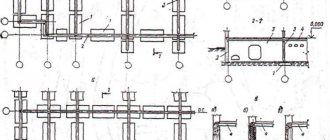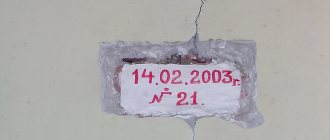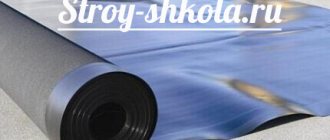Waterproofing work is an important stage in the construction of a building, since concrete structures tend to absorb moisture due to their porous structure.
To prevent the capillary effect, in which moisture spontaneously rises up the walls under the influence of surface tension forces, it is necessary to pay due attention to the horizontal waterproofing of the foundation.
Application
This type of waterproofing is used in the construction of buildings for various purposes :
- private houses,
- garages,
- commercial and industrial buildings.
It is used in regions with varied climatic conditions, even in areas where the annual level of precipitation is quite low.
The fact is that the foundation is exposed not only to storm water, but also to groundwater. Due to frequent contact with liquid, not only the gradual destruction of concrete occurs, but also corrosion of the steel reinforcement that is used in the construction of the reinforced concrete base and its base.
Horizontal waterproofing is also necessary in the following cases:
if the concrete used in the construction of the foundation does not contain hydrophobic additives and has insufficient water-repellent properties;- when the groundwater level is located at a depth of less than 1 meter under the base of the concrete foundation;
- if the foundation of the building is constantly in contact with water: for example, if the building is built on the banks of a river, lake or other body of water.
Why is waterproofing of artificial stone - concrete necessary?
Corrosion protection of building structures is divided into two types - primary and secondary.
Primary is the correct design of structures in which aggressive factors are reduced, as well as the use of materials that are resistant to the environment of future use.
Secondary protection - if the primary protection is insufficient, surface or impregnation insulation is additionally introduced.
Corrosion is understood not only as the process of metal rusting with its destruction, but also as processes leading to the destruction of concrete as an artificial stone.
Main types of concrete corrosion:
- leaching - dissolution and subsequent leaching of its, although weakly, soluble components from artificial stone when fresh water penetrates through the pores of concrete;
- acid destruction - under the influence of salts, acids and alkalis of inorganic and organic origin, soluble salts are formed in concrete stone, which are later washed out, and the remaining reaction results have a loose, non-astringent consistency, which reduces the strength of the stone.
- salt destruction - salts from external mineralized water crystallize in the pores of concrete; after its evaporation, the growth of crystals causes microstresses due to an increase in their volume, which leads to microcracks, and then to the destruction of the stone.
What materials are used?
According to the requirements of regulatory documents GOST 32384-2008 and SNiP 2.03.11-85 as amended in 2021, secondary horizontal waterproofing of foundations is created based on the following materials:
- Paint and varnish coatings . As such, special paints are used that use a bitumen or bitumen-polymer base.
- Insulating compounds . This category includes adhesive and weld-on coatings (rolled), special types of facing tiles, as well as membrane products.
- Impregnating mixtures . Such products have moisture-repellent and pore-sealing characteristics. Cement with various modifiers, as well as polymer-cement mixtures with high penetrating ability can be used as a base.
The most popular and widespread are materials of the second type. Roll and coating waterproofing is characterized by ease of application, a long service life and good water-repellent properties.
As an alternative, bridging compounds are often used . Their key feature is the ability to fill microscopic pores in the concrete structure.
The composition of such products includes special finely ground substances (for example, bitumen or cement dust), which are dissolved in water and applied to the surface to be treated, after which they penetrate the pores, harden and block the capillary channels.
Laying roll materials for waterproofing foundations
The main materials for installing a waterproofing coating are roll materials with a bitumen or polymer base with increased mechanical strength. Roll materials are fixed directly on the upper edge of the foundation. Horizontal waterproofing of foundations is performed on a flat horizontal surface of the base part of the foundation.
To achieve a flat and smooth surface, a leveling cement-sand screed is made along the upper edge of the foundation. It is best to iron the surface of the screed with dry cement, and in this case an additional element of moisture protection for the foundation will be created.
Materials for horizontal waterproofing of foundations
Technologies for insulating the foundation from moisture penetration involve the use of various materials. The most commonly used roll insulating materials are:
- Ruberoid. It belongs to the most popular and affordable type of building materials, as well as its variety - fused euroroofing felt, which successfully combines ease of use and reasonable price.
- Hydroisol. Fused sheet material is an analogue of roofing felt, with a base made of fiberglass or special fabric impregnated with bitumen compounds.
- Gidrostekloizol. Fused material based on fiberglass with increased moisture-resistant properties.
- Construction glassine. The material for production is construction cardboard impregnated with soft petroleum bitumen.
- Technoelast. Rolled material with a protective coating against the formation of fungus and mold.
Fused rolled roofing material for waterproofing
You can use any suitable rolled materials with suitable characteristics to organize moisture protection of foundations.
Instructions for performing horizontal insulation with roll materials
The technology for carrying out adhesive waterproofing work consists of step-by-step implementation:
- The prepared foundation surface is coated with a special primer based on bitumen resins or water-based, called a primer.
- After the primer has been completely absorbed, bitumen or polymer mastic is applied layer by layer to the horizontal surface with a paintbrush, trying to carefully process the outer and outer corner outlines of the foundation configuration.
- If roofing felt or similar materials are used as an insulator, there is no need to dry the bitumen mastic and the first layer of roofing felt is laid directly on the applied mastic coating. In the case of using built-up roofing materials such as euroroofing felt, it is necessary to preheat the bottom adhesive layer and fix it to the mastic, trying to carefully iron it with a roller to remove voids and air bubbles.
- To better protect the walls from the foundation, it is recommended to lay roll waterproofing in two or three layers. It should be noted that the width of the insulating coating must completely cover the entire horizontal plane of the foundation, including the finishing coating and even the internal plaster.
- When building a house with basements, horizontal insulation is installed under the base or base of the foundation structure, and horizontal waterproofing of the base is also done.
According to existing building codes and regulations (SNiP), waterproof roll insulation must be made with complete sealing of seams, joints and gaps.
Application technologies
Waterproofing coatings are applied to foundation surfaces in two main ways: cold and hot .
The cold method is used when working with ready-made bitumen mixtures or materials that require additional dilution.
The main advantage of this technology is the high speed and safety of waterproofing work. When applying waterproofing layers cold, there is no need to use additional thermal equipment, when working with which you must follow certain safety rules.
Materials are applied with ordinary brushes, rollers, spatulas and similar tools.
Hot technology involves heating rolled, solid or powdered material to a high temperature at which it melts. Molten bitumen is applied to the surface to be treated using tools equipped with elongated holders (to protect against accidental burns).
If sheet material is used, it is heated in small sections using gas burners and the heated fragments are immediately rolled out along the horizontal surfaces of the foundation.
Rolled and pasted
Roll and sheet waterproofing coatings are installed in two ways: with heating and by gluing.
The second option involves the use of additional adhesive mixtures (liquid bitumen mastic can be used as such) or self-adhesive layers.
Before applying roll and adhesive waterproofing, it is recommended to treat the surface with a primer or bitumen primer . This will achieve better adhesion and prevent premature decline in the performance properties of the material.
Penetrating method
To construct penetrating waterproofing, cement mortars containing modifying chemical additives are used.
The technology includes the following stages:
- the surface of the foundation is thoroughly cleaned to remove possible contamination and to open existing pores and cracks;
- the cement composition is mixed with modifiers (if they are not initially included in the material) and diluted with water to the optimal consistency;
- then the surface to be treated is moistened with clean water to improve adhesion;
- the final stage is the application of waterproofing material using a spatula;
- then the protective layer is left until completely dry, which takes several days.
Injection method
This method involves the introduction of waterproofing material into the foundation structure by injection. The bottom line is this: horizontal or inclined holes are drilled in the walls of a concrete structure in small increments.
Special attachments - parkers - are inserted into the prepared holes. They are necessary for uniform distribution of waterproofing material throughout the entire volume of the concrete structure. A composite mortar is then injected into the parkers to provide waterproofing.
Low pressure pumps (no more than 4 atm) are used to supply it, since too powerful pumping equipment can destroy the internal structure of concrete.
Advantages and disadvantages of different methods
The coating method of applying waterproofing has the following advantages:
- high uniformity of the layer because there are no joints;
- ease of application - with a brush, roller or spatula; for large volumes spraying is possible;
- low price of the material and its application, and much more. etc.
The disadvantages are:
- a dry surface is required; there will be no adhesion on wet concrete, i.e. the mastic will quickly peel off;
- low temperature and mechanical resistance - during frost or mechanical stress, cracks may appear, so reinforcement with polyester or fiberglass mesh is required.
There are still disadvantages, but they are not so terrible.
Features for different types of foundations
Methods for arranging waterproofing coatings are selected taking into account the design features of foundations:
Tape-type structures are treated with all the methods listed above: pasting, penetrating and injection waterproofing.
Such foundations are very easy to process, so the choice of a specific waterproofing option depends solely on the owner of the building.- When processing pile foundations, it is necessary to take into account the type of material from which the base is composed.
If reinforced concrete piles are used, they are treated on the outside with coating waterproofing mixtures. If metal piles made from hollow steel pipes are used, they must be treated on both sides. Their internal volume is filled with concrete with hydrophobic impurities, and the outer surfaces are covered with bitumen mastic. - If the foundation consists of a monolithic reinforced concrete slab , the work must be carried out in two stages.
At the first stage, it is necessary to equip a drainage system and create blind areas that will prevent groundwater from penetrating into the soil layers in direct contact with the foundation. The second stage is waterproofing treatment of the foundation structure. As a rule, coating materials are used for this: for example, bitumen mastic. The use of rolled products is also allowed.
When to use horizontal waterproofing
Each surface of the object is insulated to create protection against getting wet. For this purpose, all structural elements are carefully insulated and protected with various materials. Waterproofing work is carried out on the foundation, plinth and blind area - those elements that, in contact with the walls, can transfer accumulated moisture to the base materials.
As a result of this, mold and mildew form, the bond in the seam areas is broken, cracks appear, and the object begins to slowly collapse.
Horizontal waterproofing of the foundation with materials intended for this work reliably protects the base and base from water entering porous areas of the concrete surface.
In addition, maximum protection of the building’s structural elements from the negative effects of ground moisture is created.
Horizontal waterproofing of any foundation must be carried out in strict accordance with the requirements established by SNiP. All work is carried out with reliable moisture-proof materials, attached to the foundation base, ensuring the sealing of seam, joining and gap areas.
Cost of construction work
The costs of waterproofing work are determined taking into account several factors:
- Material type . The cheapest are rolled welded products. Their cost varies from 25 to 60 rubles per square meter. Coating protective coatings are several times more expensive, but provide a higher degree of waterproofing. Their average market price is 100-150 rubles/kg, depending on the composition. Materials based on chemical solvents cost 60-100 rubles/kg, and water-based materials cost 150-200 rubles/kg.
- Number of layers . When using materials that are applied using the cold laying method, the average consumption is about 1-1.5 kg/m2 per layer. If you use budget hot-applied waterproofing, which costs about 60 rubles/kg, with a two-layer treatment the cost of each square meter will be 120-180 rubles/m2, excluding the cost of construction services. If we take into account the costs of waterproofing work, the price will reach 500-600 rubles/m2.
Everything you need to know about foundation waterproofing can be found in this section.
Penetrating coating insulation
Coating waterproofing is applied in several layers.
It is made in the form of a primer with a thick consistency based on bitumen or cement with polymer additives, fills all microcracks in the concrete and prevents the passage of moisture through the pores of the concrete to the walls. Apply with roller, brush or spray.
Suitable as secondary protection or in climate zones with low levels of precipitation, it is necessary to equip the main waterproofing with roll materials. Apply to a dry, flat surface in several layers. The disadvantage is instability to mechanical damage.
Bituminous insulation is easy to apply, the protection period is five years, and is subject to deformation over time.
